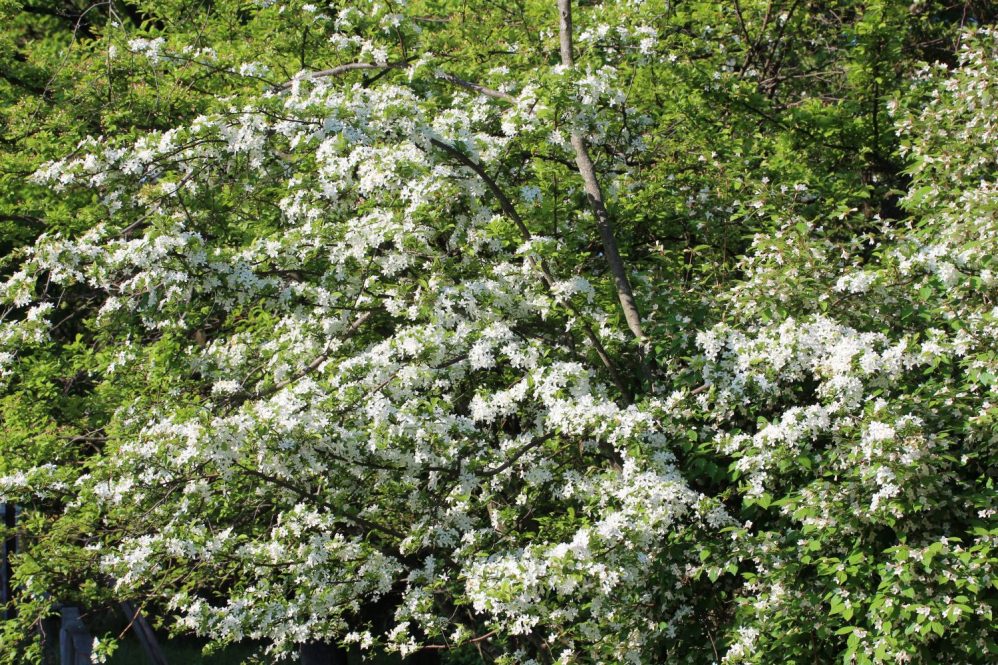Invasive plants are often beautiful and beneficial in their home regions. The problem arises when non-native plants are introduced to new regions without natural controls.
According to Lauren Kurtz, the invasive species outreach specialist with the College of Agriculture, Health and Natural Resources (CAHNR), Connecticut has 22 aquatic invasives and 75 terrestrial invasives. Some species, like Mugwort (Artemesia vulgaris), were brought to the United States in the 1600s. Many were introduced in the1800s, and others are more modern introductions.
“I was presenting about invasive plants at a local organization, and one person said it was like a horror movie,” Kurtz says. “When they learn about what it takes to manage invasive plant populations, some people feel like it’s a lost cause. Managing invasive plants is resource intensive, and takes years, but the good thing is it’s possible to manage them and improve the ecology and natural habitat.”
The reason invasives can be compared to a horror movie relates to their growth, which can explode and take over the landscape.
Oriental or Asiatic bittersweet (Celastrus orbiculatus) is an example – it is often seen strangling trees on roadsides and ultimately destroying them, however in its home region, other insects, plants, and pathogens help keep it in check.
Ultimately, invasive plants limit native plant growth; diminish our woodlands, wetlands, and meadows; and reduce wildlife habitat.
Impeding Invasives
UConn Extension and the Connecticut Department of Energy and Environmental Protection (DEEP) recognized the challenges invasive species present and convened the first Connecticut Invasive Plant Working Group (CIPWG) meeting in 1997. CIPWG’s three-part mission includes gathering and conveying information; promoting the use of native and non-invasive ornamentals; and working cooperatively with various stakeholders to proactively identify and manage invasive plants.
Vickie Wallace, sustainable landscapes and turf extension educator with UConn Extension, is one of the co-chairs of CIPWG and the 12-member steering committee.
“The Working Group is a unique mix of individuals who really want to combat invasive plants in various settings, extending from urban to rural locations. The group is comprised of experts from various government agencies and universities, including UConn Extension, providing science-based and factual information. Members include land trust employees and other landscape professionals too. Other states have their own version of CIPWG,” Wallace says.
CIPWG hosted its first biennial invasive plant symposium in 2002, with CIPWG’s size and status growing over the years. The educational conference attracts up to 500 attendees, often hosting a sellout crowd. The 2024 Symposium is on Tuesday, October 29th at UConn’s Student Union.
CIPWG also runs outreach programs on various invasives throughout the year. Individuals are trained in management strategies and the group conducts outreach across the state.
The list of invasive plants is growing too. Callery pear, Quackgrass, Japanese angelica tree, Japanese wisteria and Chinese wisteria are all being added to Connecticut’s invasive plant list effective October 1, 2024, meaning sales will then be illegal and management strategies will be adopted.
“Invasive plants are a costly problem,” Wallace says. “The United States spent $190 billion in the last four decades to control or mitigate invasive species and an additional $100 million controlling aquatic invasive plants.”
Kurtz joined the Extension team in 2024 in partnership with UConn’s Department of Plant Science and Landscape Architecture and DEEP to provide outreach on invasive plants, with a special focus on aquatic invasives.
“I’m interested in invasives because of my passion for native plants and making them more accessible,” Kurtz adds. “To improve the natural habitat and encourage native plants to thrive, you must manage the invasive species and make room for the natives, like Mountain Laurel and native oaks.”
Boaters, anglers, and lake residents are most familiar with aquatic invasive species. Kurtz is working to expand awareness of those species beyond water enthusiasts and provide further education on helping manage and mitigate spread.
Outreach messaging for aquatic invasive plants focuses on “clean, drain, and dry.” Boat owners are asked to clean their boat when they remove it from the water, specifically looking for plant debris, drain any water out of the boat, and then make sure the boat is completely dry before launching the boat at another waterbody.
Hydrilla, or water thyme, is an aquatic invasive plant seen throughout the Connecticut River and other bodies of water in the state. UConn Extension recently published a fact sheet that provides an overview of the species along with control options. This is one of many invasive plant fact sheets available. UConn Extension is also developing an invasive plant certificate program that will be available to the public.
Managing invasive plants can feel like something out of a horror movie, but transitioning to sustainable landscapes of native plants is possible.
“We need to have some tolerance, a lot of invasives have been here for hundreds of years,” Kurtz says. “Eradication isn’t the goal, it’s habitat management and making positive changes where you can. It is possible to bring back native species and improve habitat for them to thrive.”
This work relates to CAHNR’s Strategic Vision area focused Fostering Sustainable Landscapes.
Follow UConn CAHNR on social media



